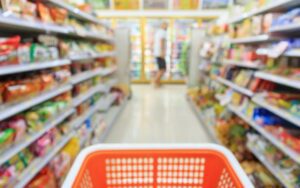The stores where we buy things are facing big problems right now, like things not being available and prices increasing. We’re expecting even more trouble with not having enough food in 2024 because of things like climate change and problems in different areas. Many of the products Britons use could be affected by floods and droughts caused by the climate crisis. Extreme weather, caused by human-driven global warming, has become common and is disrupting the global food supply. Many products bought and used in the UK are at risk of being in short supply and more expensive. For example, it is reported that the amount of French soft wheat rated as good or excellent this year is 93% less than last season. This means a much smaller percentage of this year’s wheat is considered high quality compared to last year’s crop.
This blog is here to help you understand what’s going on and get ready for it. We’ll talk about how these shortages might affect you and what you can do about it. By working together and being prepared, we can improve things and ensure everyone has enough to eat.
Factors Contributing to Food Shortages
1. Supply Chain Disruptions:
Problems like transportation delays or shutdowns can make it hard to get food from where it’s made to where it’s sold.
2. Climate Change Impacts:
Extreme weather events, like floods or droughts, can harm crops, leading to less food available in stores.
3. Economic Pressures:
When there’s inflation or economic instability, it can make it harder for people to afford food, and businesses might struggle to keep prices stable.
4. Regional Disparities and Vulnerabilities:
Some areas might have less access to food due to factors like remoteness, poverty, or conflict, making them more vulnerable to shortages.
5. Historical Precedents and Lessons Learned:
Looking back at past times when there were food shortages can help us understand what worked and what didn’t in deal with these challenges, guiding us in finding solutions now.
Potential Impacts on Consumers
- Higher Prices and Inflation:
When there’s not enough food, prices go up. This makes it harder for people to buy what they need, especially those with lower incomes. People might have to spend more money on food, leaving less for other important things.
- Limited Availability of Certain Products:
Some foods might be hard to find in stores because there isn’t enough of them. This can happen because of problems with getting the food from where it’s made to where it’s sold. So, shelves might be empty of things like bread, fruits, or vegetables.
- Shifts in Consumer Behaviour and Preferences:
When there’s a shortage, people change the way they shop. They might start buying different things or looking for food in new places, like local markets. They might also choose foods that last longer or don’t go bad quickly.
- Impact on Food Security and Vulnerable Communities:
Food shortages hit some people harder than others, especially those who already struggle to afford food. It can make it even harder for them to get nutritious meals. This affects kids, older people, and others who rely on help to get food. So, it’s important to make sure everyone can still get the food they need.
How to Prepare for Retail Sector Food Shortages
Preparing for food shortages in the retail sector can start at home and expand to your community. Here’s how:
1. Building Resilience at Home:
Stocking Up on Essentials: Keep a supply of non-perishable foods like canned goods, rice, and pasta that can last a while. Having enough food stored can help you get through shortages without worrying about empty shelves.
Diversifying Food Sources: Don’t rely only on supermarkets. Explore local farmers’ markets, co-ops, or online delivery services for fresh produce and other essentials. Having different places to get food from can help you find what you need even if one source runs low.
Learning Basic Cooking and Food Preservation Skills: Knowing how to cook simple meals from scratch and how to preserve food, like freezing or canning, can come in handy during shortages. It helps you make the most of what you have and reduces waste.
2. Community-Level Preparedness:
Establishing Local Food Networks: Work with neighbours to create networks for sharing food and resources. This could involve setting up community gardens, food co-ops, or sharing excess produce from backyard gardens.
Collaborating with Neighbours and Community Organizations: Talk to your neighbours and local organizations about working together to support each other during shortages. This could include sharing information, and resources, or organizing community events focused on food security.
Advocating for Policy Changes and Support: Get involved in advocating for policies that support food security and resilience in your community. This could involve lobbying for improved access to healthy food options, supporting local farmers, or pushing for government assistance programs for those in need. By working together at the community level, you can strengthen your resilience to food shortages and support each other through challenging times.
Strategies for Retailers and Suppliers
Here’s a detailed look at how retailers and suppliers can prepare for and respond to food shortages:
1. Improving Supply Chain Resilience:
Investing in Technology and Infrastructure: Retailers and suppliers can invest in technology such as inventory management systems, predictive analytics, and automation to improve efficiency and visibility across the supply chain. Upgrading infrastructure, including transportation and storage facilities, can also enhance the ability to respond quickly to disruptions.
Strengthening Supplier Relationships: Building strong relationships with suppliers is crucial for ensuring a reliable flow of goods. This involves open communication, collaboration, and mutual support. Developing long-term partnerships and diversifying the supplier base can help mitigate risks associated with dependence on a single source.
Implementing Risk Management Strategies: Retailers and suppliers should proactively identify potential risks in the supply chain and develop strategies to mitigate them. This includes assessing vulnerabilities, developing contingency plans, and regularly monitoring and evaluating performance. Implementing measures such as safety stock, alternative sourcing options, and supply chain mapping can enhance resilience to disruptions.
2. Enhancing Communication and Transparency:
Keeping Consumers Informed: Transparent communication with consumers is essential during times of food shortages. Retailers and suppliers should provide accurate and timely information about product availability, pricing, and any supply chain challenges. This can be done through various channels such as websites, social media, and in-store signage.
Managing Expectations and Demand: Managing consumer expectations is critical to avoid panic buying and hoarding behaviours that can exacerbate shortages. Retailers can implement measures such as setting purchase limits, offering alternative products, and communicating realistic timelines for replenishing stock. Additionally, proactive communication about efforts to address shortages and reassure customers can help maintain trust and confidence.
Addressing Concerns and Feedback: Creating avenues for consumers to voice their concerns and provide feedback allows retailers and suppliers to address issues and improve service. This could involve setting up dedicated customer service channels, conducting surveys, or engaging with customers through social media. Responding promptly to inquiries and complaints demonstrates accountability and a commitment to customer satisfaction.
By implementing these strategies, retailers and suppliers can enhance their resilience to food shortages, maintain trust with consumers, and effectively manage disruptions in the retail sector.
Read More: Is The UK About to Face Food Shortages?
Conclusion:
In conclusion, as we navigate the challenges posed by potential food shortages in the retail sector, it’s essential to recognize the factors contributing to these disruptions and their impacts on consumers. From supply chain disruptions to shifts in consumer behaviour, the effects of food shortages can ripple through communities, particularly affecting vulnerable populations. To address these challenges, proactive steps must be taken at both individual and collective levels. This includes stocking up on essentials, diversifying food sources, and fostering community networks for support and resilience.
Moving forward, it’s imperative to urge action and preparedness among individuals, retailers, and suppliers alike. By investing in technology, strengthening relationships, and enhancing communication, we can build a more resilient and responsive food system. Moreover, collective efforts and collaboration are essential in mitigating food shortages and ensuring food security for all. Let’s harness our collective resources, creativity, and compassion to navigate these challenges and create a future where everyone has access to nutritious and affordable food, even in times of uncertainty.





